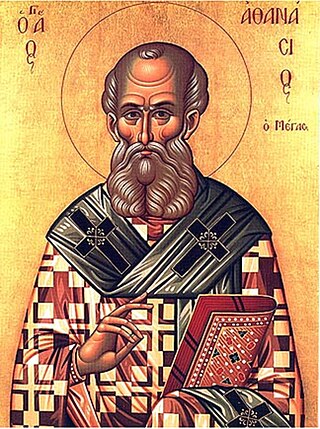
Athanasius I of Alexandria, also called Athanasius the Great, Athanasius the Confessor, or, among Coptic Christians, Athanasius the Apostolic, was a Christian theologian and the 20th pope of Alexandria. His intermittent episcopacy spanned 45 years, of which over 17 encompassed five exiles, when he was replaced on the order of four different Roman emperors. Athanasius was a Church Father, the chief proponent of Trinitarianism against Arianism, and a noted Egyptian Christian leader of the fourth century.
The 360s decade ran from January 1, 360, to December 31, 369.
The 340s decade ran from January 1, 340, to December 31, 349.
The 350s decade ran from January 1, 350, to December 31, 359.
The 290s decade ran from January 1, 290, to December 31, 299.

Year 361 (CCCLXI) was a common year starting on Monday of the Julian calendar. At the time, it was known as the Year of the Consulship of Taurus and Florentius. The denomination 361 for this year has been used since the early medieval period, when the Anno Domini calendar era became the prevalent method in Europe for naming years.

Year 359 (CCCLIX) was a common year starting on Friday of the Julian calendar. At the time, it was known as the Year of the Consulship of Eusebius and Hypatius. The denomination 359 for this year has been used since the early medieval period, when the Anno Domini calendar era became the prevalent method in Europe for naming years.

Year 357 (CCCLVII) was a common year starting on Wednesday of the Julian calendar. At the time, it was known as the Year of the Consulship of Constantius and Iulianus. The denomination 357 for this year has been used since the early medieval period, when the Anno Domini calendar era became the prevalent method in Europe for naming years.
Year 353 (CCCLIII) was a common year starting on Friday of the Julian calendar. At the time, it was known as the Year of the Consulship of Magnentius and Decentius. The denomination 353 for this year has been used since the early medieval period, when the Anno Domini calendar era became the prevalent method in Europe for naming years.
Year 352 (CCCLII) was a leap year starting on Wednesday of the Julian calendar. At the time, it was known as the Year of the Consulship of Decentius and Paulus. The denomination 352 for this year has been used since the early medieval period, when the Anno Domini calendar era became the prevalent method in Europe for naming years.
Year 346 (CCCXLVI) was a common year starting on Wednesday of the Julian calendar. In the Roman Empire, it was known as the Year of the Consulship of Constantius and Claudius. The denomination 346 for this year has been used since the early medieval period, when the Anno Domini calendar era became the prevalent method in Europe for naming years.
Year 344 (CCCXLIV) was a leap year starting on Sunday of the Julian calendar. At the time, it was known as the Year of the Consulship of Leontius and Bonosus. The denomination 344 for this year has been used since the early medieval period, when the Anno Domini calendar era became the prevalent method in Europe for naming years.
Year 343 (CCCXLIII) was a common year starting on Saturday of the Julian calendar. At the time, it was known as the Year of the Consulship of Memmius and Romulus. The denomination 343 for this year has been used since the early medieval period, when the Anno Domini calendar era became the prevalent method in Europe for naming years.
Year 339 (CCCXXXIX) was a common year starting on Monday of the Julian calendar. At the time, it was known in Rome as the Year of the Consulship of Constantius and Claudius. The denomination 339 for this year has been used since the early medieval period, when the Anno Domini calendar era became the prevalent method in Europe for naming years.

Year 335 (CCCXXXV) was a common year starting on Wednesday of the Julian calendar. At the time, it was known as the Year of the Consulship of Constantius and Albinus. The denomination 335 for this year has been used since the early medieval period, when the Anno Domini calendar era became the prevalent method in Europe for naming years.

This is a chronology of warfare between the Romans and various Germanic peoples. The nature of these wars varied through time between Roman conquest, Germanic uprisings, later Germanic invasions of the Western Roman Empire that started in the late second century BC, and more. The series of conflicts was one factor which led to the ultimate downfall of the Western Roman Empire in particular and ancient Rome in general in 476.
The siege of Autun was a conflict fought between the Roman Empire and the invading barbarian Alamanni tribe, who were ravaging Gaul, in 356 AD. The Romans successfully defended the city, and the barbarians retreated on the approach of reinforcements.
The Battle of Brumath in 356 AD was part of Roman Emperor Julian's campaigns against the Germanic tribes. Following the Battle of Reims, Julian's forces pursued several Germanic war bands through the Gallic countryside. Outside Brocomagus (Brumath), one war band met Julian in open battle and the Romans were victorious.
Eusebius was a high-ranking officer of the Roman Empire, holding the position of praepositus sacri cubiculi during the rule of Emperor Constantius II (337-361).

Serapion of Nitria, Serapion of Thmuis, also spelled Sarapion, or Serapion the Scholastic was an early Christian monk and bishop of Thmuis in Lower Egypt, born in the 4th century. He is notable for fighting alongside Athanasius of Alexandria against Arianism.







